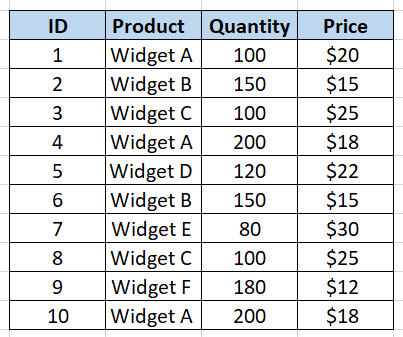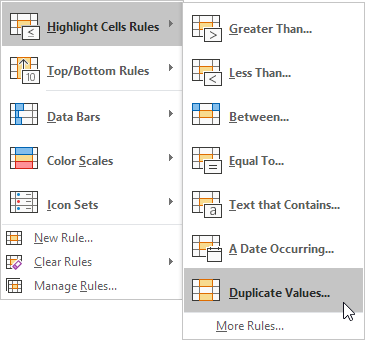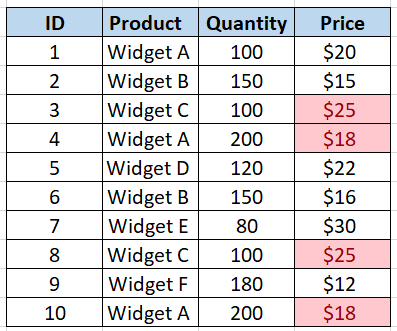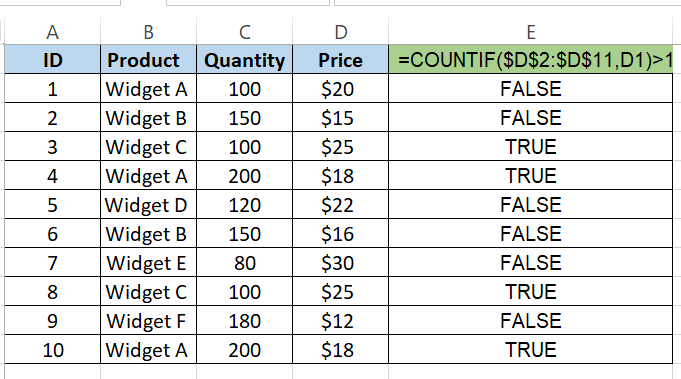Microsoft Excel offers various methods to identify and manage duplicate data within your spreadsheets. Whether you're working with a small dataset or a large database, efficient duplicate management is essential. In this article, we'll explore several approaches to finding duplicates in Excel.
How to Find Duplicates in Excel
1. Conditional Formatting:
Conditional formatting is a visual way to highlight duplicate values in your dataset.
- Select the range of cells containing your data. (lets select the "Price" row)

- Navigate to the "Home" tab on the ribbon.
- Click on "Conditional Formatting" in the "Styles" group.

- Choose "Highlight Cells Rules" and then "Duplicate Values."

- Customize the formatting options and click "OK."

This method visually identifies duplicate values, making them easy to spot in your spreadsheet.

2.COUNTIF Function:
The COUNTIF function helps identify duplicates by counting the occurrences of each value.
- Create a new column next to your data.
- Use the following formula (adjust the range based on your data)
excel formula
=COUNTIF($A$2:$A$100, A2)>1Drag the formula down to apply it to all cells.

Filter or sort the new column to view and manage duplicates.
This method provides a systematic way to identify duplicates based on a count criterion.
3.Find Duplicates with Macro
Step 1: Open the VBA Editor
- Press Alt + F11 to open the Visual Basic for Applications (VBA) editor.
Step 2: Insert a New Module
- In the VBA editor, right-click on any item in the left pane (e.g., "VBAProject (YourWorkbookName)").
- Choose
Insertand thenModule.
Step 3: Copy and Paste the VBA Code
- Copy the following VBA code:
Sub HighlightDuplicatesInSelection()
' Check if a range is selected
If TypeName(Selection) <> "Range" Then
MsgBox "Please select a range of cells first.", vbExclamation
Exit Sub
End If
Dim selectedRange As Range
Set selectedRange = Selection
' Loop through each cell in the selected range
For Each cell In selectedRange
' Check if the value is a duplicate within the selected range
If WorksheetFunction.CountIf(selectedRange, cell.Value) > 1 Then
' Highlight the cell with a specified color (yellow in this example)
cell.Interior.Color = RGB(255, 255, 0)
End If
Next cell
' Display a message indicating the process is complete
MsgBox "Duplicate highlighting process completed successfully.", vbInformation
End Sub
- Paste the code into the module you inserted in Step 2.
Step 4: Close the VBA Editor
- Close the VBA editor by clicking the "X" button or pressing Alt + Q.
Step 5: Select the Range in Excel
- In your Excel workbook, select the cell or range of cells where you want to highlight duplicate values.
Step 6: Run the Macro
- Press
Alt+F8to open the "Macro" dialog. - Select the macro named "
HighlightDuplicatesInSelection" from the list. - Click "Run."
Step 7: View Results
- Observe that the selected cells with duplicate values are highlighted in yellow.
Note:
- You can modify the color of the highlight by adjusting the
RGBvalues in the code. - Ensure that you save your workbook as a macro-enabled workbook (.xlsm) if prompted.
Following these steps will help you use the provided VBA code to highlight duplicate values in a selected range within your Excel workbook.
FAQ's
Q1: How do I find duplicates in a specific column in Excel?
A1: To find duplicates in a specific column in Excel, you can use the "Remove Duplicates" feature. Here are the steps:
-Select the column or range where you want to find duplicates.
-Go to the "Data" tab on the ribbon.
-Click on "Remove Duplicates" in the "Data Tools" group.
-In the Remove Duplicates dialog box, select the columns where you want to find duplicates.
-Click "OK" to let Excel identify and remove duplicate values.
Q2: Can I find duplicates in multiple columns simultaneously?
A2: Yes, you can find duplicates in multiple columns simultaneously using the "Remove Duplicates" feature. When selecting columns in the Remove Duplicates dialog, ensure that you choose all columns where you want to identify duplicate values. Excel will consider a row as a duplicate if all selected columns have the same values.
Q3: How do I highlight duplicates without removing them?
A3: To highlight duplicates without removing them, you can use conditional formatting. Here's how:
-Select the range where you want to find duplicates.
-Go to the "Home" tab on the ribbon.
-Click on "Conditional Formatting" and choose "Highlight Cells Rules."
-Select "Duplicate Values" from the dropdown menu.
-Choose a formatting style for highlighting and click "OK."
Q4: Is there a way to find duplicates based on case sensitivity?
A4: Yes, Excel's "Remove Duplicates" feature is case-sensitive by default. If you want to find duplicates without considering case differences, uncheck the "Case-sensitive" option in the Remove Duplicates dialog.
Q5: Can I find duplicates using a formula?
A5: Yes, you can use formulas like COUNTIF or COUNTIFS to find duplicates in Excel. For example, to check for duplicates in column A, you can use the formula =COUNTIF($A$1:$A$100, A1)>1 and apply it to the entire column.
Q6: How do I find duplicates in Excel and keep the original data?
A6: To find duplicates and keep the original data, you can use the "Conditional Formatting" feature to highlight duplicates. After that, you can filter or sort the highlighted cells to review and manage duplicate values while retaining the original data in the worksheet.
Q7: Can I find duplicates in Excel with a specific condition?
A7: Yes, you can use the "Custom Formula" option in conditional formatting to find duplicates based on specific conditions. For example, you can highlight duplicates where values are greater than a certain threshold.
Q8: How do I find duplicates in a large dataset efficiently?
A8: For large datasets, consider using Excel's "Remove Duplicates" feature. Additionally, creating a helper column with formulas like COUNTIF to identify duplicates can be efficient. This approach allows you to filter or sort the data based on the helper column.
Q9: Is there a quick way to find and highlight duplicates in Excel?
A9: Yes, a quick way to find and highlight duplicates is to use the "Conditional Formatting" > "Highlight Cells Rules" > "Duplicate Values" option. Excel will automatically highlight the duplicate values in the selected range.
Q10: Can I find duplicates in Excel using VBA (Visual Basic for Applications)?
A10: Yes, you can use VBA to find duplicates in Excel. Custom macros can be created to identify and highlight or remove duplicates based on specific criteria. VBA provides flexibility for handling duplicates in a customized manner.


You must be logged in to post a comment.